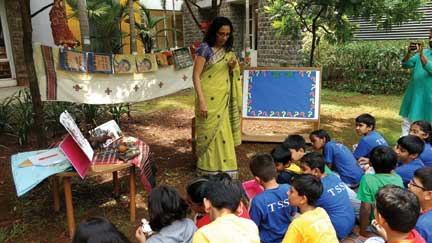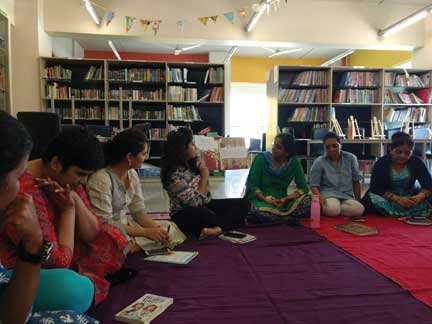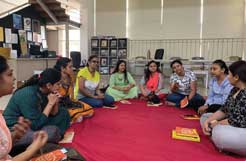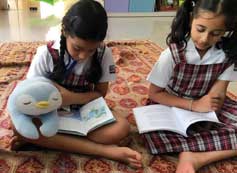Nirupama Kaushik
“What a school thinks about its library is a measure of what it feels about education.” – Harold Howe
The Somaiya School is an English medium, CBSE school situated in the heart of Mumbai city. Apart from its infrastructure and verdant campus, a notable feature of the institution is its continuous attempt to build a vibrant library for all stakeholders. This article aims to highlight how the library became a space for everyone.
When the school started in 2012, the library was equipped with books and other learning resources in abundance. The bookshelves provided open access to users. It was one of the first spaces in the school to have a projector and computer installed. However, despite the time, money, effort, and energy that had gone into setting up the library, the space was sorely under-used. Students attended the library period once a week. Their time was spent in borrowing books and filling up a “Book Review” worksheet. Several books collected dust on the shelves because nobody evinced any interest in browsing through the entire collection. Except for the students and librarians, the place had no visitors. Teachers came only when they had to attend staff meetings or required a subject related textbook. Parents were conspicuously missing.

I joined the school in 2017 as a Library Educator. At that time, Parveen Shaikh, Principal of the school, was completing the Library Educators Course by Bookworm, Goa. Her experience during the course and our conversations about school libraries led us to one question – How can we make our library a more vibrant place? In 2018, I registered for the course.
Our time at Bookworm gave us the opportunity to interact with participants from different walks of life. People from community libraries spoke of challenges that they faced regarding funds, management decisions and resources. School librarians shared about how their day was spent in fulfilling other duties like ‘proxy’ periods rather than investing time in the profession. Some participants had joined the course because they were looking to shift careers and the course had piqued their curiosity. Interacting with all the participants and faculty members made me reflect on our own practice. For the first time, I looked at the elements of a library – collection, people, interactions, activities, administration and space – through a refreshed, more critical lens and understood how the parts came together to become a whole. The sessions were an immersive experience. We were gently nudged to question the values associated with the library, re-imagine our space and activities, and review the gaps in our collection. Most importantly, we began to think of our users as the epicentre. What we put on our bookshelves, the objective behind every activity, the ambience we created in the library – all these made a strong impact on our readers. Hence, we needed to choose wisely. As a result of this shift in our approach to ‘library education’, we embarked on a series of field projects.
Parveen’s field project emerged on the grounds of an observation of students’ borrowing data, which revealed that students borrowed books written by selected authors and of some types; ignoring the diverse collection of more than 4500 books (as of 2017) in the primary school library. It was an attempt to open the vast collection that existed through systematically planned and designed sessions. Books were selected to highlight the different facets of diversity such as gender, disability, race, rural and urban contexts and lives of tribal communities. As stated in the article Libraries Need Diverse Books, ‘Diverse books can help dismiss stereotypes and prejudice, foster compassion and empathy and inspire children to imagine even more – especially when they see that they can be the face of their own story’ (Nichole Overton 2016). Parveen chose to work with 30 students of grade 5. The books used were:
• The Unboy Boy by Richa Jha and Gautam Benegal
• Wings to Fly by Sowmya Rajendran
• Nabiya by Chatura Rao
• Follow the Drinking Gourd by Jeanette Winter
• Why Why Girl by Mahashweta Devi

The sessions led to the students becoming more aware of the collection in the library. Instead of borrowing popular books like Geronimo Stilton all the time, they began to select books like Mayil Will Not Be Quiet and The Boy in The Dress where the characters are set in a socio-economic milieu that is starkly different from the lives of the students themselves. The students were slowly becoming more mindful of their choices. The use of different places to conduct the sessions – the corridors, the garden – made us think of how the library can extend beyond a particular room. It also taught us that library activities need not be rigid and should allow for variations in responses. However, pre-set objectives are always helpful to maintain the pace and systematic flow of the class.
My field project was inspired by a paper written by Harry K. Hutton titled ‘Professors as Teachers and Readers’. With all the ideas from LEC, I began to engage in conversations with teachers to understand why they did not use the library. Their reasons included lack of time, lack of awareness about genres and labelling themselves as non-readers. Most did not view reading as a pleasurable activity. According to the Position Statement by the National Council for Teachers of English, “When teachers read and enjoy quality literature with confidence, they contribute to the rich, literate environment of classrooms”. With a diverse collection at hand, teachers can sensitize their students to the social, educational, and cultural needs of the world around them. But for that, they must first acquaint themselves with the collection. I decided to work with 15 pre-primary teachers and through carefully planned sessions, I hoped to motivate them to read different genres with pleasure and purpose. Some of the books I included were:
• Sam and Dave Dig A Hole by Jon Klassen
• Poetry by Shel Silverstein
• Catch that Cat by Tharini Vishwanath
• Journey by Aaron Becker (Wordless picture book)
Initially, the teachers were reluctant to pick books to read stating that their schedules were packed but the conscious use of only picture books for the sessions helped to overcome their apprehensions. From one book per week, they began borrowing 3-4 and made time to read them. The genre that caught their attention the most was Wordless Picture Books. The use of art, role-play and a treasure hunt activity made them engage with books with enthusiasm instead of thinking of it as a daunting task.

In both the field projects, each session began with a pre-reading activity like solving a puzzle, using cubes with questions about the cover page or viewing a video related to the theme. This was followed by reading a picture book aloud and finally a post session reflection activity.
We included extensive use of displays in the library. During the LEC sessions, we had experienced the charm of book displays that not only showcased the collection under different themes but also engaged the audience through an interactive element like writing a poem related to the display, stringing beads, dropping a pebble in a jar if we liked the display, putting up a piece of art, etc. According to Donald Biskin and Kenneth Hoskisson, “Interaction is necessary for two reasons: it is the basic source of knowledge for children and it provides the conflict that is necessary for the development of new cognitive structures.” Using displays in the library, we were able to appeal to the visual senses of our users and evoke an interest. Displays continue to be a regular, much loved feature of the library which now involves curation and creation by students.

Another element that defined the course of the projects was experimenting with picture books and read-aloud sessions. Whether our participants were students or teachers, we discovered that the power of a picture book combined with reading the story aloud with pauses for meaningful questions, sharing and the right amount of expression and voice modulation cannot be underestimated. Read-aloud sessions have become an integral part of our school’s library programme where all teachers are invited to read a story to different grades. Some of the favourites are Tikki Tikki Tembo, The Paper Bag Princess, Neel on Wheels and What A Song. Even the students of Grade 10 revel in picture books as they find that the themes give them a different perspective (and who can resist the illustrations?) All that students read is shared with others through book talks. During the library period, two students share their thoughts on a book that they enjoyed reading, reading out extracts and responding to questions from the listeners.
Lastly, our collection needed to be revamped. “Book collections require a discernment of a far serious kind when talking of multiple contexts and languages” states Sujata Noronha in ‘Why a Library Program in Schools and the Community’. She further says that “All categories of Children’s Literature should find representation in a good collection within the library”. Our users needed to read stories in which they found themselves or those that gave them an avenue to think divergently. This led us to weed out our massive repository and we let go of ‘moral’ stories and books with illustrations and plots that reinforced stereotypes. The exercise also revealed that certain genres like poetry for children, comics, process books, non-fiction themes were conspicuously missing. We are now more mindful when we buy reading material for the library. Instead of filling the empty spaces, we review every book to gauge how it adds value to the collection with regard to diversity and inclusion. A key question we ask is – whom does this story represent and is the voice authentic?
The thrust that LEC gave us has put us on a path of experimenting with ideas in the library. Earlier, we were bound by the framework that has defined school libraries for eons. Initially, we struggled with structuring the library period and were hesitant about choosing books that were ‘unorthodox’. But with consistent review of our practice, we have been able to bring more users into the library (including parents), create displays that are alluring and meaningful, invite teachers to share about the books they have read through the library blog and are now working on integrated teaching in the library too. We are more confident of pushing the limits.

A school library can be an ocean of calm amidst all the chaos that surrounds the education world today. It is a place that invites users to think, feel, create, share, and collaborate with one another. Whether it is a discussion on the latest graphic novel, volunteering to make posters for the space or repairing damaged books, running a book club for parents or keeping score during a Scrabble match, we ensure that there is learning that is joyful and lasts for a lifetime.

And yes, guests, parents, staff members, students – all are welcome!
With valuable inputs from Parveen Shaikh.
References
- Overton, N (2016).Libraries need diverse books. Public Libraries Online.
- http://www2.ncte.org/statement/teachersasreaders/
- Johnston, Vickie. The Power of The Read Aloud in The Age of The Common Core. The Open Communication Journal. 2015. 9 (Suppl: M5). pp 34-38
- Moral Development Through Children’s Literature. Author(s): Donald Biskin and Kenneth Hoskisson. Source: The Elementary School Journal. Vol. 75, No. 3 (Dec., 1974), pp. 152 – 157. Published by : The University of Chicago Press
The author is the Primary Section Coordinator and Library Educator of The Somaiya School, Mumbai. She supports the development of cognitive, social and emotional skills in children and teachers through books and stories. She can be reached at nirupama.k@somaiya.edu.
